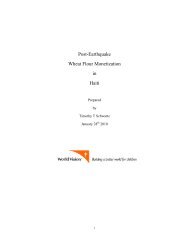Food Consumption Patterns Part 2
You also want an ePaper? Increase the reach of your titles
YUMPU automatically turns print PDFs into web optimized ePapers that Google loves.
88<br />
Problems and Inefficiencies in the Production and Market Chain<br />
There are apparent problems and inefficiencies in the peanut production process and marketing<br />
chain in Haiti. TechnoServe sums them up as the lack of a relationship of prices paid to quality of<br />
peanuts, or moisture content, and zero awareness of aflatoxin (something Western researcher on<br />
the topic determine to be a dangerous carcinogen). 3 Another issue is that, as with most products<br />
seen earlier, the final peanut butter products sold even in elite super markets have no labels and no<br />
expiration dates. TechnoServe analysts also conclude that Haitian peanuts are costly—with<br />
shelled peanuts prices averaging 1600 and 2500 USD/MT in Haiti vs. 1250 to 1350 USD on the<br />
international market.<br />
The reality of retail market price suggests that there is, in fact, something highly cost efficient<br />
about the local value chain. Despite claims of seasonal shortages, TechnoServe observed a constant<br />
year-round flow of peanuts into Port-au-Prince’s primary produce market (Bosal). The costs of<br />
peanuts and peanut butter on the street also are remarkably consistent, changing seasonally by a<br />
factor of only 25%, compared to the 300% variation for peanut seed in rural areas. This is true for<br />
two reasons, 1) the shelf life of peanuts and peanut products--raw peanuts can be stored for 3 to 4<br />
month and peanut butter stores for another 2 to 3 months, easily spanning the two seasons, and 2)<br />
seasonal mountain vs. plain harvests found throughout Haiti result in 3 to 4 harvest periods per<br />
year.<br />
Local processed peanuts and peanut butter are not only preferred by consumers, they are 25% less<br />
expensive for consumers than the imported counterparts (see Table 23). Moreover, while taxes<br />
and transport on imported shelled peanuts bring the price for a MT to USD $1,900, the low point<br />
for shelled Haitian peanuts, at harvest, is $800 USD/MT. In effect the market chain, actors and<br />
interplay of profits in Haiti seem to work out to the benefit of the urban consumer.<br />
Table 25: Imported vs. Local Peanut Butter Prices for Port-au-Prince Super Markets<br />
Imported<br />
Local<br />
Market Name<br />
Lowest cost<br />
(Haitian HG)<br />
Size<br />
(grams)<br />
Lowest cost<br />
(Haitian HG)<br />
Size<br />
(grams)<br />
Sigo Market 145 349 130 454<br />
Deli Mart 151 340 117 227<br />
Delmas 2000 192 227 125 454<br />
Belmart 195* 115 190 454<br />
Eagle Market 230 462 130 454<br />
Star Market 135 340 150 454<br />
Compas Market 155 340 120 454<br />
Ratio of HG/gram 0.48 0.39<br />
Ratio of cents/gram 0.97 0.77<br />
Excluded from the ratios as an outlier<br />
3<br />
Anecdotally, we can attest that popular class know nothing of the threat of aflatoxin and even educated Haitian<br />
elites typically refuse to accept it as a credible hazard
















